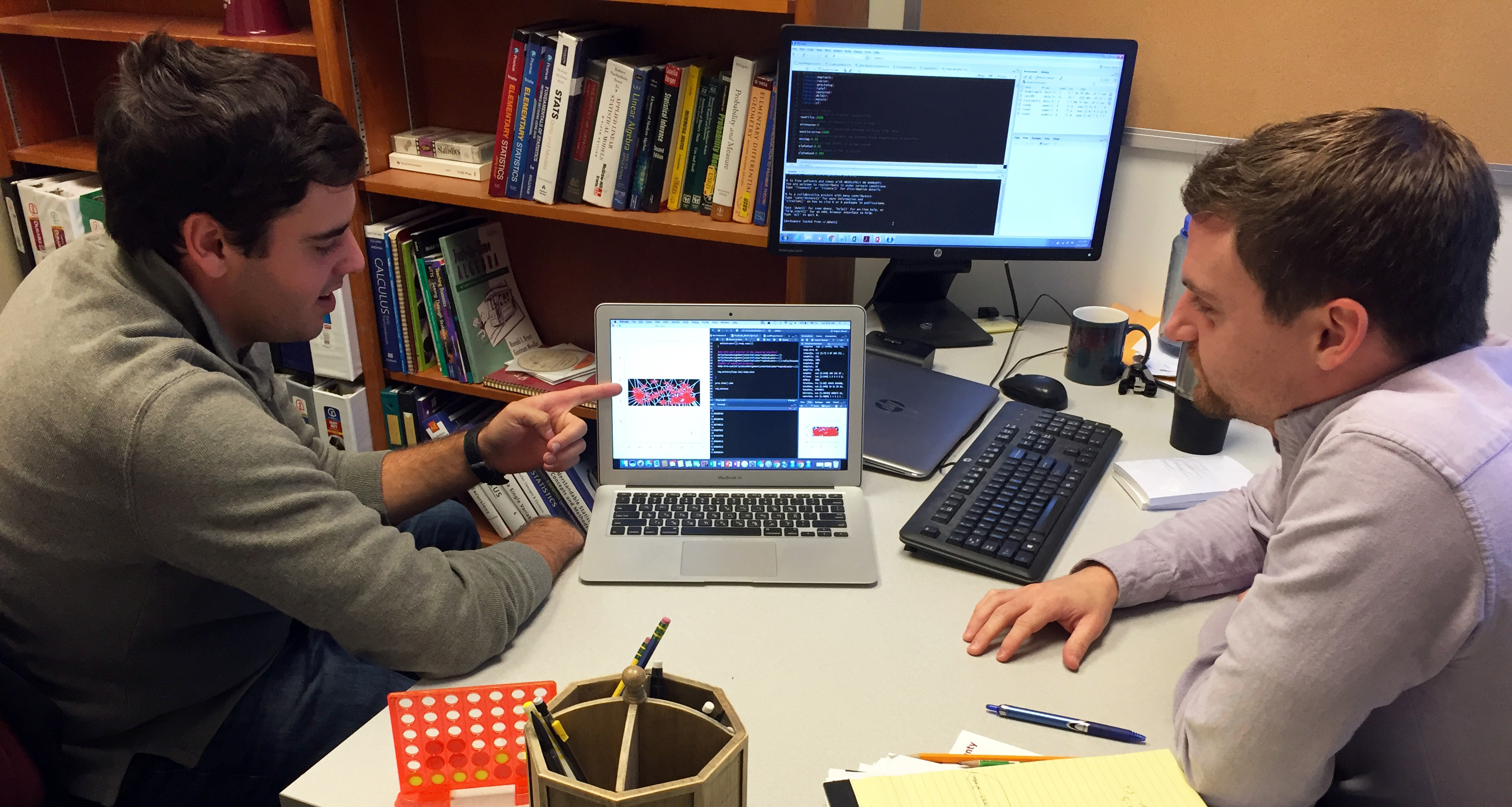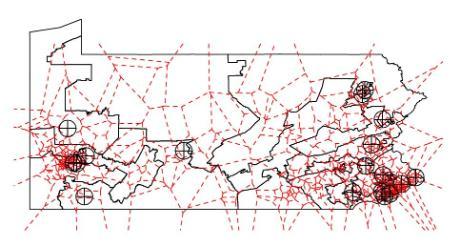Does a Congressional Map Unfairly Favor One Political Party? There’s Math for That
Undergraduate research on gerrymandering proves timely as Pennsylvania Supreme Court rules congressional map is unconstitutional.By: Meghan Kita Tuesday, October 17, 2017 02:00 PM
 Ben Lieberman ’19 and assistant professor Jim Russell review some of the data from their research on partisan gerrymandering. Photo by Meghan Kita.
Ben Lieberman ’19 and assistant professor Jim Russell review some of the data from their research on partisan gerrymandering. Photo by Meghan Kita.
Updated January 31, 2018:
Last week, the research by Ben Lieberman ’19 and Professor Jim Russell on partisan gerrymandering in Pennsylvania became even more relevant and the topic made headlines around the country. The big news? The Pennsylvania Supreme Court ruled the congressional map unconstitutional and ordered the state legislature to draw a new one immediately, before the May primaries.
Ben and Russell have been busy these past few months. Ben recently presented their research at the Joint Mathematics Meeting in San Diego and they are in the process of preparing a paper for submission to peer-reviewed journals.
When Ben Lieberman ’19, a mathematics and finance major, and Jim Russell, assistant professor of mathematics and computer science, chose the summer research topic they’d tackle together, they didn’t know it would become headline news. But on June 19, weeks after their statistical analysis of partisan gerrymandering in Pennsylvania began, the Supreme Court announced it would hear Gill v. Whitford—a case about partisan gerrymandering in Wisconsin—in the fall.
“People know partisan gerrymandering exists but the problem is there hasn’t been a great method to measure it. It’s a much more challenging project than I thought,” Russell says. “Our timing is clearly good,” Ben adds.
The Supreme Court heard arguments on the case October 3. News reports focused on Justice Anthony Kennedy, whose vote will likely decide the case’s outcome. The decision will answer the question: Should courts be able to decide when gerrymandering—the redrawing of Congressional districts every 10 years to reflect updated census data—is too partisan?
The Supreme Court has considered this issue before: In 2004, in Vieth v. Jubelirer, the Court upheld a lower court’s ruling that the gerrymander in question was not unconstitutional. Kennedy, the swing vote in that ruling, argued that the Court shouldn’t get involved until it could apply a “workable standard” across cases to determine the constitutionality of a given map.
The algorithm Ben and Russell developed could be that workable standard. And their preliminary data shows, mathematically, that Pennsylvania’s map may indeed be “too partisan.”
To determine that, they used census data to map where in Pennsylvania voters live and what their party affiliations are. A computer randomly drew 50 different Congressional-district maps that fit these legal standards: Each district must be similar in population (in the simulation, that meant no more than one percent more or less populous than the others), and each district must be contiguous (so, you can’t draw “islands” in different parts of the state and call them one district). Then, they determined which party would win in each district based on the voters’ affiliations.
Pennsylvania has 18 Congressional districts. In real life, Republicans control 13 of those districts. In the 50 simulations, the highest number of seats won by Republicans was 11, which only happened twice. More data is needed to make this research publishable, Russell says, and that’s what Ben is working to gather this fall. Still, “if we cut up the state 1,000 times, maybe Republicans will get 13 seats once,” Russell says.
This kind of statistical approach to gerrymandering isn’t completely new: A method developed by Jowei Chen of the University of Michigan and David Cottrell of Dartmouth College has been cited in briefs submitted to the Supreme Court for Gill v. Whitford. “Their method uses less data but is similar in that it shuffles around the districts,” Ben says. “But there are so few comprehensive mathematical methods of doing this.”
The next step for Ben and Russell is to run more simulations and, hopefully, present their updated data at the Joint Mathematics Meetings in San Diego next January. After that, the goal is to publish their research—a lengthy process that will likely take longer than the Supreme Court takes to make its decision. (One is expected next spring.) Still, Ben now has research experience he can draw on as he applies to grad schools next year, and both of them have the potential to make a political mark if the court rules against partisan gerrymandering.
“I love working with students, particularly on a project they’re interested in,” Russell says. “Hopefully this will be applicable to the real world.”
At left, a map of Pennsylvania from the data set, cut up (the red lines are smaller district cuts, which are the “sub-districts”). The crosshairs represent the centers of the districts. Image courtesy Ben Lieberman.

